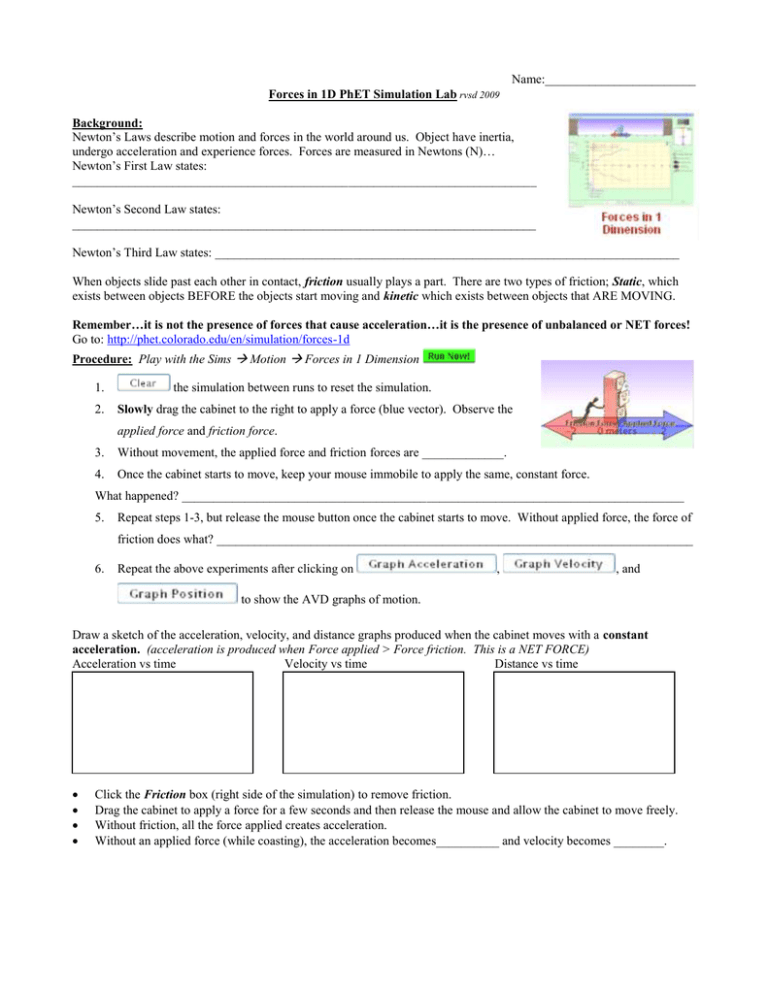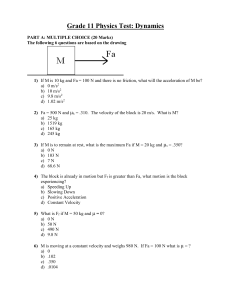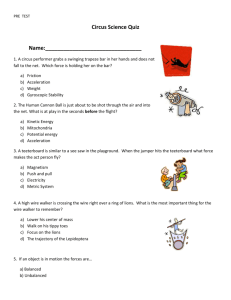Forces in 1D Phet Lab
advertisement

Name:________________________ Forces in 1D PhET Simulation Lab rvsd 2009 Background: Newton’s Laws describe motion and forces in the world around us. Object have inertia, undergo acceleration and experience forces. Forces are measured in Newtons (N)… Newton’s First Law states: __________________________________________________________________________ Newton’s Second Law states: __________________________________________________________________________ Newton’s Third Law states: __________________________________________________________________________ When objects slide past each other in contact, friction usually plays a part. There are two types of friction; Static, which exists between objects BEFORE the objects start moving and kinetic which exists between objects that ARE MOVING. Remember…it is not the presence of forces that cause acceleration…it is the presence of unbalanced or NET forces! Go to: http://phet.colorado.edu/en/simulation/forces-1d Procedure: Play with the Sims Motion Forces in 1 Dimension 1. 2. the simulation between runs to reset the simulation. Slowly drag the cabinet to the right to apply a force (blue vector). Observe the applied force and friction force. 3. Without movement, the applied force and friction forces are _____________. 4. Once the cabinet starts to move, keep your mouse immobile to apply the same, constant force. What happened? ________________________________________________________________________________ 5. Repeat steps 1-3, but release the mouse button once the cabinet starts to move. Without applied force, the force of friction does what? ____________________________________________________________________________ 6. Repeat the above experiments after clicking on , , and to show the AVD graphs of motion. Draw a sketch of the acceleration, velocity, and distance graphs produced when the cabinet moves with a constant acceleration. (acceleration is produced when Force applied > Force friction. This is a NET FORCE) Acceleration vs time Velocity vs time Distance vs time Click the Friction box (right side of the simulation) to remove friction. Drag the cabinet to apply a force for a few seconds and then release the mouse and allow the cabinet to move freely. Without friction, all the force applied creates acceleration. Without an applied force (while coasting), the acceleration becomes__________ and velocity becomes ________. The Math of Newton’s Second Law: Click on CLEAR” to reset the simulation. Keep friction turned off during the next set experiments. Set the Force on the slider (on the left) to a value as shown in the boxes below. (Press “CLEAR”, type in value, press ENTER”) Determine the acceleration from the acceleration-time graph. Click “GO” to begin Force applied Mass (cabinet) acceleration Force applied Mass (cabinet) acceleration 100. N 200. kg 50. N 200. kg 200. N 200. kg 20. N 200. kg 400. N 200. kg 10. N 200. kg 600. N 200. kg Fill in the table below and check your work with the simulations. GRADED ½ point each Force applied Mass (fridge) acceleration 800. N 400. kg 1. 50. N 400. kg 2. 1000. N 400. kg 3. Force applied Mass (dog) acceleration 25. N 25.0 kg 4. 5. 25.0 kg 2.0 m/s2 200. N 25.0 kg 6. Force applied Mass (large book) acceleration 5. N 10.0 kg 7. 20. N 10.0 kg 8. 9. 10.0 kg 4.0 m/s2 Force applied Mass (crate) acceleration 100. N 300. kg 10. 300. N 300. kg 11. 12. 300. kg 2.5 m/s2 Conclusion Questions: 1. As a small force was applied to the cabinet, the cabinet didn’t move because the magnitude of the force of friction was larger than / smaller than / equal to the applied force. BE CAREFUL HERE 2. Our experiment showed that static (not moving) friction is greater than / less than kinetic (moving) friction. 3. I’m not accelerating, so the net (vertical) force on me, while I’m sitting here doing this lab is _________. 4. Without friction, applying a constant force produces a decreasing / constant / increasing acceleration. 5. Without friction, applying a constant force produces a decreasing / constant / increasing speed. 6. While coasting (no applied force) without friction, the acceleration is __________ and velocity is ________________. 7. When a force of 300. N is applied to an object that experiences 200. N of friction the net force that will cause acceleration would be ___________. 8. Imagine you push a 50. kg crate with 200. N of force. If friction pushes back with 100 N of force, the crate will accelerate with a magnitude of __________m/s2.






